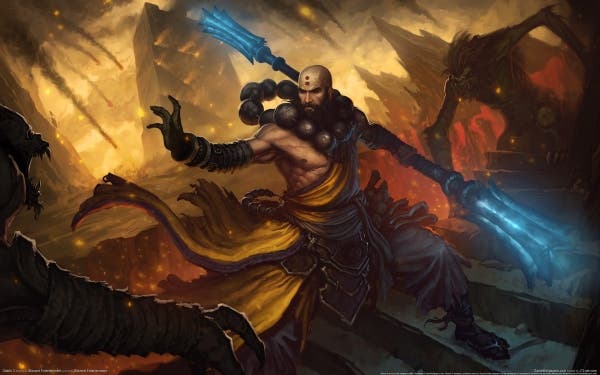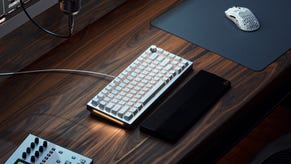Diablo 3 Monk tips - Follower gear, sockets, levelling builds, Torment gear, armour sets
How to get a Monk to Level 70 fast, equip it for end-game farming, spend your Paragon points pool to maximum effect, and socket the best gems.
Diablo 3's Monk class relies on a flurry of fists and high-powered kicks to dish out its damage, and if you're looking for a melee class that packs a genuine thrill, you can't really go wrong with it. It can be a challenging class for a newcomer to take on and gear up effectively, however, so here's a quick run-down of how to get to grips with this nimble warrior.
Levelling up a Monk
As you pick up bits of new equipment here and there, equip the pieces that have the highest Dexterity rating while you're making your way to Level 70. You're an extremely up-close-and-personal character though, so be sure to keep your Vitality rating high as well.
To take some of the sting out of the levelling process, consider putting a Ruby into your Helm so that monster kills reward you with a little more experience. If you can socket Rubies into any of our weapons, you'll also benefit from a nice boost to your damage. You'll benefit greatly from an area-of-effect damage build as you level, and if you'd rather not create your own then we recommend checking out Noxxic's collection of combat builds.
It's important to push yourself as much as possible as you level up. You want to find the difficulty setting that provides enough experience and loot boosts to make the extra effort worthwhile, while not bogging you down so much that you could have cleared a lower difficulty more quickly and efficiently.
Choosing the right Follower for a Monk
Generally speaking, it's always a good idea to select a Follower that benefits from the same primary stats as your hero - for the Monk, that means picking the Scoundrel. By making this selection, you get to gift your old armour to him as you find better upgrades for yourself. Everybody wins.
With that said, if you're playing the game on Hardcore difficulty, you might want to think about using the Templar instead. You won't find him as easy to gear up as a result, but he's got some extremely useful survival skills that will go some way to preventing your permanent demise.
How to gear up a Monk for Torment
When hunting down your first gear at Level 70 - whether from the Gambler or by killing monsters - you should try and prioritise certain stats for certain pieces of equipment. As a general rule, you want as much Dexterity as possible as the primary stat on every piece of equipment. This rating is, after all, how you derive the greatest overall boost to your damage.
Beyond Dexterity, different armour slots suit different stat priorities. Gloves, Amulets and Rings are always great for deriving elemental damage or crit-based stats, and you should craft a Reaper's Wraps for your Bracer slot if you're able to. Your Head item can provide critical damage power, and you want to equip Chest and Legs items that have three and two sockets respectively.
Weapons should have as high a damage and Dexterity rating as possible, as well as crit damage as standard. Get a socket on the weapon as well and pop your best Emerald in. Now's a good time to check your overall Critical Hit Chance and Critical Hit Damage stats, and make whatever tweaks are necessary to keep them in an approximate 1:10 ratio with each other.

The best gems for a Monk
As you level up, you want to pack the best Ruby you have access to into your weapon. This will give you the best damage output on the road to level 70, but once you hit the end-game you should replace it with an Emerald. If you find yourself looting a Head slot with a spare socket, then by all means whack a Ruby in there for a little boost to your experience gains. If you've unlocked the Mystic, you can re-roll a useless Head gear stat into a socket if you're lacking one.
For pure damage output, you can't really go wrong with stacking your best Emeralds into every other available slot. These will boost up your Dexterity skill rating, and Dexterity is key to increasing a Monk's combat prowess. Should you find yourself dying a lot, you can look into switching one or two Emeralds out for a Diamond or an Amethyst. It depends a great deal on your specific character, build and circumstances, however - this need to remain flexible is a common theme with the Monk.
End-game Monk equipment
As you grind for other gear, make sure you complete as many Act 1 Bounty sessions as you can stomach, to get your hands on the Ring of Royal Grandeur. Once equipped, you'll be able to receive the special bonuses from armour sets with one less piece of each particular set equipped. A Stone of Jordan is the other must-have ring in terms of overall usefulness.
Monks are less set-dependant for optimal combat than other classes, and so there's a wider range of viable equipment to aim for. With that said, you won't go far wrong by equipping a couple of pieces of Aughild's armour, and tracking down a good Magefist for your Gloves slot. Fill the rest to balance out your build, as well as the other items you've been lucky enough to loot. You will, of course, also want to tweak your build to accommodate the bonuses of your precious new items.
Need more Diablo 3 help? Learn how to unlock Zelda outfits like Ganondorf in Diablo 3 Switch, get some Diablo 3 boss strategies, and learn how use the Mystic, Blacksmith, Gambling and Horadric Caches. We also have advice for every class, from the Barbarian to the Crusader, Demon Hunter, Monk, Witch Doctor and Wizard.
How to spend Paragon points on a Monk
In the Core category, we recommend investing in movement speed so you can get around those farming spots just a little more quickly. In the Offense category, we like to invest in Critical Hit Chance and Critical Hit Damage - keeping these two stats in a 1:10 ratio with each other right across the board is a sensible aim.
As for Defense, we think it makes sense to invest in the Resist All category, but once you feel you've got enough of this to survive, consider switching into Life. For the final Utility section, we like Area Damage for raw power output, but by all means switch to Life On Hit if you're having survival issues. Don't forget that you can reset your Paragon points at any time - and for the Monk more than any other class, you'll have to do so often in order to remain effective in combat.
Head back to to the first page of this article for all of our essential Diablo 3 crafting guides.








.jpg?width=291&height=164&fit=crop&quality=80&format=jpg&auto=webp)
